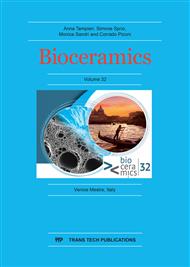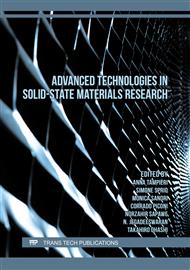p.69
p.79
p.89
p.95
p.103
p.109
p.115
p.125
p.135
Processing by Laser Stereolithography and In Vitro Biological Evaluation of Hydroxyapatite Scaffolds Mimicking Human Trabecular Bone Architecture
Abstract:
Hydroxyapatite (HA) ceramic scaffolds are commonly used as bone graft substitutes. Design of such scaffolds is a challenge to improve biological properties and extend the applications of HA ceramics in the field of bone tissue engineering. In this work, we investigated the processing and the in vitro properties of HA ceramic scaffolds mimicking human trabecular bone architecture. Samples of human tibial trabecular bone were collected (University Hospital Center of Limoges) and scanned by X-Ray μ-computed tomography (μ-CT) to generate 3D model database. From this computer-aided design, HA ceramic scaffolds were shaped layer-by-layer by additive manufacturing using laser stereolithography (SLA). Then, green parts were sintered to obtain dense ceramic scaffolds. The shaped parts were compared to the model (wall thickness, size, and geometry of the porous network) using image analysis. A good agreement was found. Only small differences were detected due to a light overpolymerization or to some unprinted very small details that were not linked to a polymerized area of the previous layer. Due to part shrinkage during sintering a magnifying factor has to be applied to the scanned CAO model to match the real dimensions of the trabecular bone sample. Human mesenchymal stem cell (hMSC) cultures were performed to investigate the biological properties of these scaffolds (cell attachment and proliferation of hMSC). These preliminary biological evaluations show the good biocompatibility and cell adhesion of the HA substitute. This work evidences the efficiency of SLA to produce ceramic scaffold architectures mimicking that of the natural trabecular bone with promising biological behavior.
Info:
Periodical:
Pages:
103-108
Citation:
Online since:
December 2022
Price:
Сopyright:
© 2022 Trans Tech Publications Ltd. All Rights Reserved
Share:
Citation:



